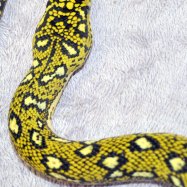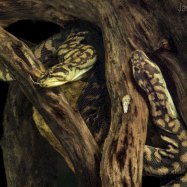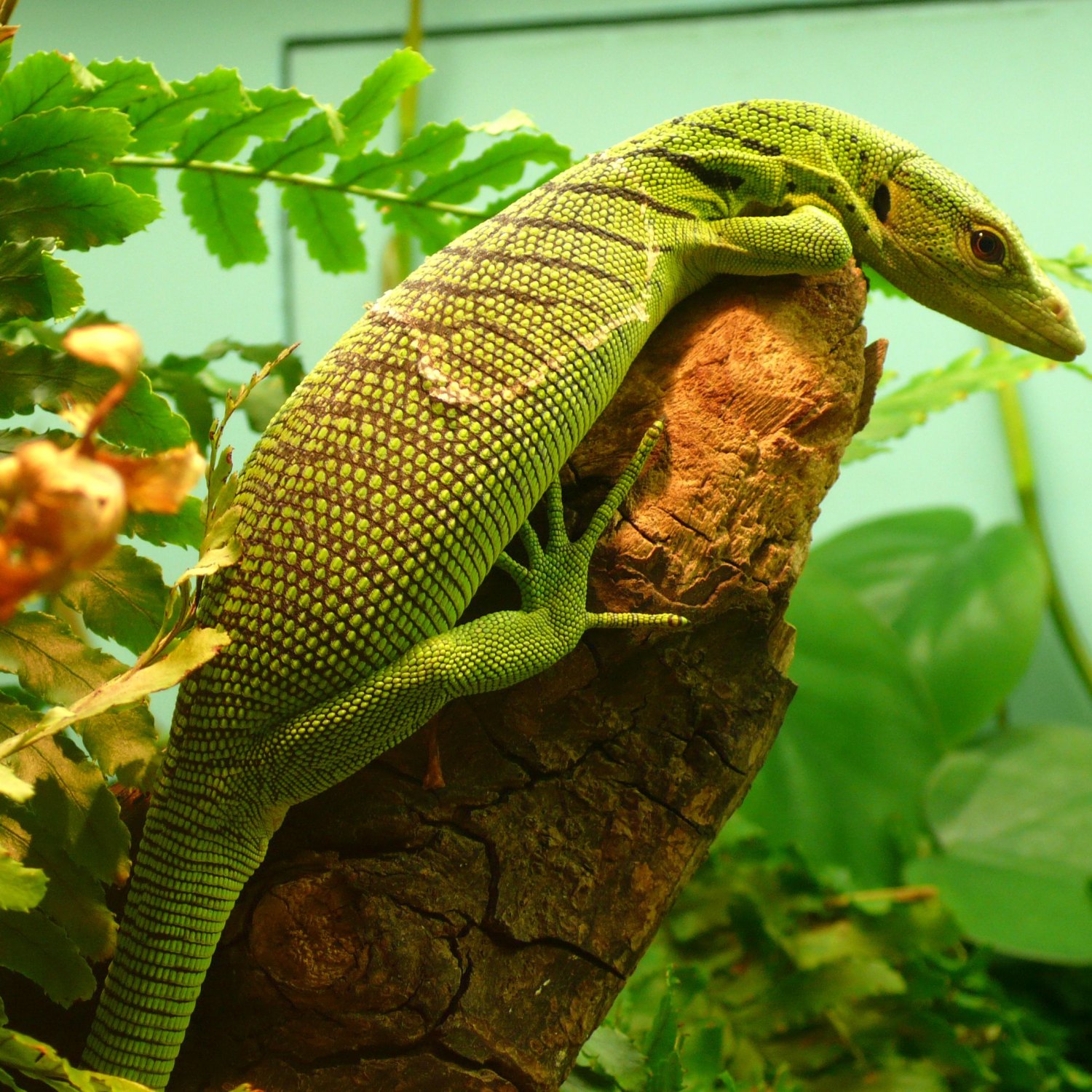
Emerald Tree Monitor
60-90 cm
The Emerald Tree Monitor, found in the tree canopies, is a striking lizard with an elongated, slender body. Measuring between 60-90 cm, it belongs to the Varanidae family and is a popular pet among reptile enthusiasts. Its bright green color and arboreal lifestyle make it a unique addition to any collection. #EmeraldTreeMonitor #Varanidae #Reptile #ArborealLizard
Animal Details Summary:
Common Name: Emerald Tree Monitor
Kingdom: Animalia
Habitat: Rainforests
The Magnificent Emerald Tree Monitor: The Hidden Jewel of the Rainforest
Tucked away in the lush rainforests of New Guinea, lives a striking yet mysterious reptile – the Emerald Tree Monitor. Scientifically known as Varanus prasinus, this vibrant creature is also commonly referred to as the Emerald Tree Monitor, due to its distinctively bright green coloration. With its unique physical features and elusive nature, the Emerald Tree Monitor has always been a subject of fascination for scientists and reptile enthusiasts alike.A Rare Gem: Taxonomy and Habitat
Belonging to the Kingdom Animalia, Phylum Chordata, and Class Reptilia, the Emerald Tree Monitor is a part of the Squamata order and Varanidae family Emerald Tree Monitor. They are closely related to Komodo dragons and other monitor lizards but have evolved separately for millions of years.These rare reptiles are primarily found in the dense rainforests of New Guinea, a large island situated in the southwestern Pacific Ocean, shared by Indonesia and Papua New Guinea. They inhabit the canopy of the trees that make up their natural habitat and are rarely seen on the forest floor. The exceptional tree-climbing abilities of the Emerald Tree Monitor allow them to effortlessly move through the dense vegetation and evade predators.
The Elusive Hunter: Feeding Habits
The Emerald Tree Monitor is a carnivorous species and is known for its potent hunting skills. These solitary creatures mainly feed on a variety of invertebrates, including insects, snails, spiders, and even eggs. They also have a taste for small mammals, birds, and reptiles, and have been observed preying on frogs, lizards, and even snakes.Their long and slender body shape, along with sharp claws and a prehensile tail, makes them well-adapted climbers and hunters. The elongated tongue of an Emerald Tree Monitor helps them to track their prey's scent accurately, making them efficient hunters even in the dense canopy of the rainforest Echidna.
The Hidden Treasure: Physical Characteristics
One of the Emerald Tree Monitor's most striking features is its vibrant green coloration, which gives it its namesake. The bright green skin, with yellow spots scattered all over, helps them camouflage perfectly in the dense rainforest, making them challenging to spot. However, these colorful lizards can also change their skin coloration according to their mood, from light green when alert to a darker shade when they feel threatened or stressed.Apart from its bright coloration, the Emerald Tree Monitor has other notable physical characteristics that make it stand out from other lizards. With an average length of 60-90 cm, they have a long and slender body, with their tail making up more than half of their body length. This prehensile tail also helps them to balance while climbing and acts as an extra limb to grasp onto branches while moving through the tree canopy.
A Glint of Emerald: Country of Origin and Distribution
The Emerald Tree Monitor can only be found in the tropical rainforests of New Guinea, which are the only parts of the world where they are endemic. This means that they are native only to a specific region and are not found anywhere else. In New Guinea, they are mostly found in Indonesia, particularly on the western part of the island, and in Papua New Guinea, the eastern part.The species has a relatively limited distribution, as they prefer the tall trees and dense vegetation found in the rainforest. Deforestation and habitat destruction are the primary threats to the Emerald Tree Monitor, and as a result, their numbers are slowly declining.
A Precious Jewel in the Wild: Conservation Status
The Emerald Tree Monitor is currently listed as a vulnerable species on the International Union for Conservation of Nature (IUCN) Red List. This means that they are facing a high risk of endangerment in the wild, and their population is declining rapidly.Loss of habitat due to deforestation and illegal wildlife trade are the primary threats to the Emerald Tree Monitor. Their eye-catching coloration also makes them a target for the exotic pet trade, and many have been illegally captured and sold as pets. However, efforts are being made to protect this precious species, and conservation programs are in place to protect their natural habitat and regulate the illegal trade of these magnificent lizards.
The Mystery Behind the Emerald Green: Behavior and Reproduction
Due to their elusive nature, not much is known about the Emerald Tree Monitor's behavior and reproduction. However, it is believed that they are primarily arboreal, meaning they spend most of their time in trees. They are also diurnal, which means they are active during the day and rest at night.During the breeding season, males become more active and may engage in aggressive behaviors to attract females. After mating, female Emerald Tree Monitors lay an average of 4-6 eggs that are guarded and incubated by the male. It is thought that the eggs hatch after approximately 7-9 months, and the offspring are born with bright emerald green coloration, unlike other reptile hatchlings that are dull in color.
A Rare Sighting: The Experience of Witnessing an Emerald Tree Monitor
As mentioned before, the Emerald Tree Monitor is a rare species to spot in the wild, due to their elusive nature and limited distribution. However, ecotourism and guided tours in specific regions of New Guinea do offer a glimpse into these beautiful creatures' lives.Even though their natural habitat is challenging to access, observing an Emerald Tree Monitor in the wild is a magical experience. Their vibrant coloration against the backdrop of a lush green rainforest, along with their unique physical features and behaviors, make them one of the most fascinating creatures in nature.
The Future of the Emerald Tree Monitor
With ongoing conservation efforts and programs in place, it is hopeful that the future of the Emerald Tree Monitor will be a brighter one. However, it is also essential for us to understand the crucial role these reptiles play in maintaining the balance of the rainforest ecosystem. As the destruction of their natural habitat continues, it not only threatens the existence of the Emerald Tree Monitor but also other species that depend on the rainforest.As we continue to discover more about these elusive creatures, we must also make efforts to preserve their habitat and ensure their survival. The magnificent Emerald Tree Monitor serves as a reminder of the beauty and diversity of nature, and we must strive to protect it for generations to come.

Emerald Tree Monitor
Animal Details Emerald Tree Monitor - Scientific Name: Varanus prasinus
- Category: Animals E
- Scientific Name: Varanus prasinus
- Common Name: Emerald Tree Monitor
- Kingdom: Animalia
- Phylum: Chordata
- Class: Reptilia
- Order: Squamata
- Family: Varanidae
- Habitat: Rainforests
- Feeding Method: Carnivorous
- Geographical Distribution: New Guinea
- Country of Origin: Indonesia and Papua New Guinea
- Location: Tree canopies
- Animal Coloration: Bright green with yellow spots
- Body Shape: Elongated and slender
- Length: 60-90 cm

Emerald Tree Monitor
- Adult Size: 60-90 cm
- Average Lifespan: 12-20 years
- Reproduction: Oviparous
- Reproductive Behavior: Mating occurs during the dry season
- Sound or Call: Silent
- Migration Pattern: Non-migratory
- Social Groups: Solitary
- Behavior: Arboreal, diurnal, and territorial
- Threats: Habitat loss and collection for the pet trade
- Conservation Status: Vulnerable
- Impact on Ecosystem: Play a role in maintaining balanced ecosystems by controlling populations of their prey species
- Human Use: Captivity for the pet trade
- Distinctive Features: Bright green coloration, long tail, and sharp claws
- Interesting Facts: They are excellent climbers and spend most of their time in trees
- Predator: Snakes, birds of prey, and larger monitor lizards
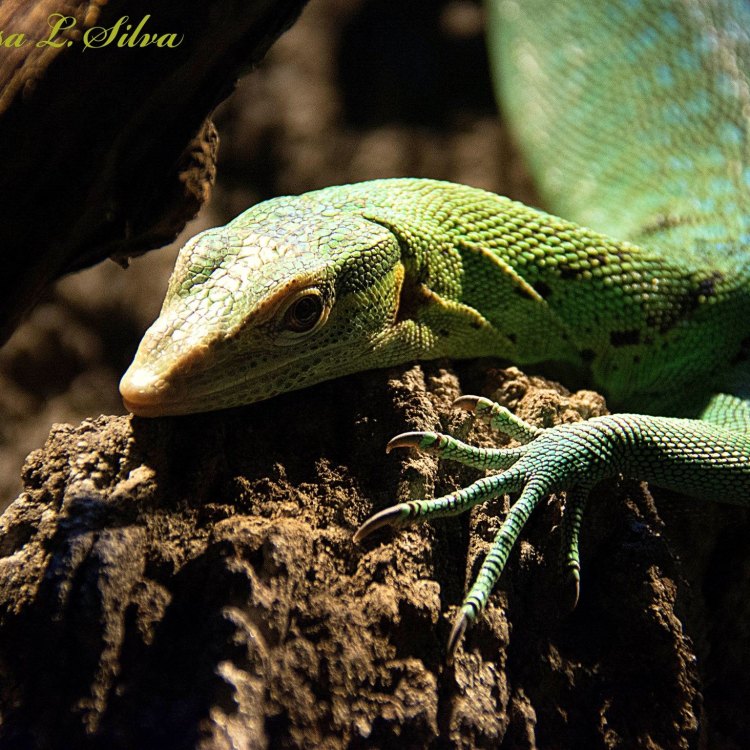
Varanus prasinus
The Fascinating World of the Emerald Tree Monitor
Nature has a way of creating stunning creatures that never fail to captivate our imagination. One such mesmerizing creature is the Emerald Tree Monitor (Varanus prasinus), also known as the Green Tree Monitor or the Prasinus Monitor. This strikingly beautiful lizard is found in the tropical rainforests of New Guinea and some nearby islands. With their bright green coloration, long tail, and sharp claws, these reptiles are truly one of a kind PeaceOfAnimals.Com.The Emerald Tree Monitor, as the name suggests, is a monitor lizard, belonging to the Varanidae family, which includes the famous Komodo Dragon. However, unlike its larger, more aggressive cousin, the Emerald Tree Monitor is a relatively small and peaceful lizard. They are one of the smallest members of the Varanus genus, reaching an adult size of only 60-90 cm. Despite their small size, these lizards have a long lifespan of 12-20 years, making them a popular choice among reptile enthusiasts.
Reproduction in Emerald Tree Monitors is an interesting process. They are oviparous, meaning they lay eggs instead of giving birth to live young. Mating typically occurs during the dry season, which is usually between October to March. During this time, male monitors become more territorial and often fight with other males to establish dominance and gain the attention of females. Once a successful male-female pair is formed, mating takes place, and the female will lay her eggs in a suitable nesting site Eryops.
One unique aspect of these lizards is their silent nature. Unlike many other lizards, Emerald Tree Monitors do not vocalize or make any sounds or calls. This may be due to the fact that they are solitary creatures, preferring to live and hunt alone. They are also very secretive, making it challenging to study their behavior in their natural habitat.
Despite their solitary behavior, Emerald Tree Monitors play a vital role in maintaining balanced ecosystems. As arboreal creatures, they spend most of their time in trees, where they prey on small mammals, birds, and insects. This helps to control the populations of these species, ultimately supporting the overall health of the ecosystem. However, the reverse is also true. Any disturbance or decline in their populations can have a cascading effect on the entire ecosystem.
Sadly, Emerald Tree Monitors are facing numerous threats in their natural habitat. Habitat loss due to deforestation for agriculture and logging is a significant concern for their survival. Additionally, they are also collected for the pet trade. Even though these lizards are protected by law, they are still illegally hunted and traded, leading to a decline in their numbers. As a result, the International Union for Conservation of Nature (IUCN) has listed them as a vulnerable species.
One of the main reasons why Emerald Tree Monitors are sought after for the pet trade is because of their distinctive features. Their bright green coloration, long tail, and sharp claws make them visually striking. However, it is essential to note that not all of them have a vibrant green color. In their natural habitat, they can have variations of green, blue, and yellow, depending on their age and location. Additionally, their long tail helps them with balance and agility while navigating through the trees, making them excellent climbers.
In captivity, Emerald Tree Monitors require specialized care and a suitable habitat to thrive. They need a tall enclosure with plenty of climbing branches, plants, and hiding spots to mimic their natural habitat. The enclosure should also have a UVB light source to provide them with essential vitamins and promote healthy growth. As they are diurnal creatures, they require a consistent day and night cycle, along with a varied diet of insects, rodents, and other small prey.
Aside from their distinctive features and behavior, Emerald Tree Monitors have some other interesting facts that make them even more intriguing. For example, they have a unique respiratory system that allows them to absorb oxygen through their skin, making them semi-aquatic. They are also known for their exceptional agility, capable of making 90-degree turns while running at high speeds. Additionally, their sharp claws, used for climbing and hunting in the wild, can cause serious injuries to humans if not handled properly.
Even though Emerald Tree Monitors are small, they still face threats from natural predators. Snakes, birds of prey, and larger monitor lizards are potential threats to these lizards. However, they have adapted several defense mechanisms to protect themselves, such as camouflage, rapid movements, and their sharp claws and tail.
In conclusion, the Emerald Tree Monitor is a fascinating and unique lizard that continues to amaze us with its distinct features and behavior. Their role in maintaining the balance of their ecosystem, coupled with their striking appearance, makes them an essential and valuable species. However, it is crucial to protect them from human-driven threats and preserve their natural habitat to ensure their survival for generations to come. As responsible individuals, it is our duty to appreciate and admire these beautiful creatures in their natural environment rather than keeping them as pets. After all, they are meant to be left in the wild, where they truly belong.
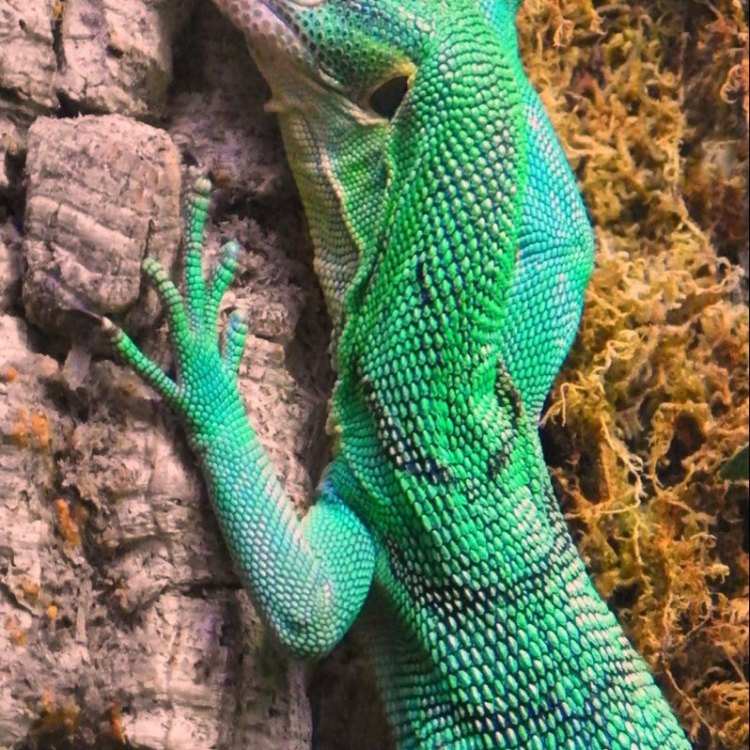
The Magnificent Emerald Tree Monitor: The Hidden Jewel of the Rainforest
Disclaimer: The content provided is for informational purposes only. We cannot guarantee the accuracy of the information on this page 100%. All information provided here may change without prior notice.





